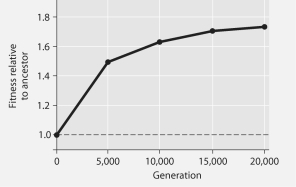Multiple Choice
The following questions refer to Figure 27.1 below, which is the same as Figure 27.10 in the textbook.
In this 8-year experiment, 12 populations of E. coli, each begun from a single cell, were grown in low-glucose conditions for 20,000 generations. Each culture was introduced to fresh growth medium every 24 hours. Occasionally, samples were removed from the populations, and their fitness in low-glucose conditions was tested against that of members sampled from the ancestral (common ancestor) E. coli population.

Figure 27.1
-If it occurs in the absence of any other type of adaptation listed here, which of these is least reasonable in terms of promoting bacterial survival over evolutionary time in a low-glucose environment?
A) increased efficiency at transporting glucose into the cell from the environment
B) increased ability to survive on simple sugars, other than glucose
C) increased ability to synthesize glucose from amino acid precursors
D) increased reliance on glycolytic enzymes
E) increased sensitivity to, and ability to move toward, whatever glucose is present in its habitat
Correct Answer:

Verified
Correct Answer:
Verified
Q1: During which two times can the recipient
Q3: Figure 27.2 depicts changes to the amount
Q4: Which of the following are responsible for
Q5: Which statement about gram-negative bacteria is correct?<br>A)Penicillins
Q6: Match the numbered terms to the descriptions
Q7: Foods can be preserved in many ways
Q10: The following questions refer to structures found
Q11: The following questions refer to Figure 27.1
Q27: Which of the following obtain energy by
Q34: If all prokaryotes on Earth suddenly vanished,